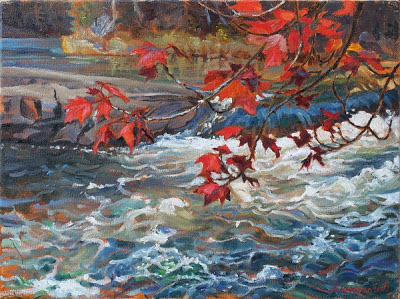Forest Tea (oil on canvas, 6 x 6 in.)
7 July found me lagging behind on the trail, with my camera, trying again to find a paintable view of one of the little brownwater brooks crossed by footbridges on the Five Fathom Hole Trail near Prince of Wales, New Brunswick. We were returning from where I'd been painting "High Lookout From the Trail," tired after a hot day which started with having Fred briefly in hospital for diabetic shock, and then my teaching the plein air painting workshop on the wharf. With only a few days more before we had to head home to Ontario I knew I must take reference photos for finishing this series of paintings.
This lovely brook collects rain water that has been steeped in the forest - dripped from leaves, trickled down bark, soaked through
moss, steeped in fallen leaves, and filtered past roots. I could hear it laughing as we approached one of the footbridges, and then it came into view from a tangle of flooded sticks and branches hung up between overhanging mossy banks. Full of humic stains and organic acids from its passage through the forest, the brook is as red as freshly brewed Orange Pekoe or Rooibos tea.
This lovely brook collects rain water that has been steeped in the forest - dripped from leaves, trickled down bark, soaked through
moss, steeped in fallen leaves, and filtered past roots. I could hear it laughing as we approached one of the footbridges, and then it came into view from a tangle of flooded sticks and branches hung up between overhanging mossy banks. Full of humic stains and organic acids from its passage through the forest, the brook is as red as freshly brewed Orange Pekoe or Rooibos tea.
Water levels were high throughout our visit because of the recent heavy rain - when we first went past these brooks on the Fathom Five Trail they were turbid with clay, but in a few days the water was clear and this remarkable reddish brown, which I wanted to paint each time I saw it.
One feature of many of these Maritime streams is that although they may be pristine, they have a very limited fauna, because after deglaciation they rose out of the sea without any, or a long enough, connection for freshwater-dependent species to reach them. Of course, invasive aliens of various kinds can be carried in by human activity, so it would have been nice to have had time and low water enough to investigate these little brooks in the Musquash Estuary, to see how much of the usual fauna (salamanders, fish, crayfish, molluscs, and insects) are present.
The plant material that falls into streams - ‘allocthonous organic carbon’ of technical jargon - feeds the animal life of the stream. This food chain starts with ‘shredders’ who chew up and swallow leaves and wood in the forest, passing out the depleted fragments. Microorganisms grow on and in the plant fragments, and as successive consumers processes this detritus the particles become smaller.
And not just leaves - wood is as important to the life of the stream as it is to the forest floor, so it is important to have these entire little watersheds protected from human disturbance. These little brooks play an important part in the ecology of the Estuary, bringing nutrients from the forests out to feed the biodiversity of the marshes.
Large chunks of wood control the shape of the channel and the movement of sediment and water, providing habitat structure and complexity for aquatic and terrestrial species. Historically, there were logs in all streams, but with active removal, channelization, and deforested shores, there’s less and less wood in streams around the world. To maintain complex aquatic habitat we’ve got to understand the physical and biological linkages among streams, riparian zones, and uplands throughout a watershed, and allocthonous wood, leaves, and dissolved organic material from forested shores are one of the most important links.
Dear patrons and supporters,
This is one of a series of paintings of the Musquash Estuary Natural Area, where we explored forest, marshes and shores protected by the Nature Conservancy of Canada. The price of this painting is $325. If you would like to purchase it, please contact me.




Comments
Post a Comment
What do you think of this painting, and what do you know about the subject that I have painted?